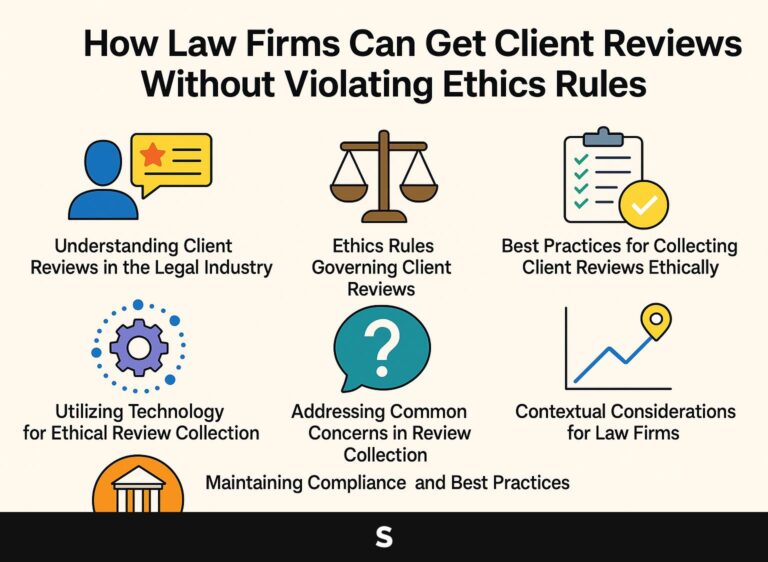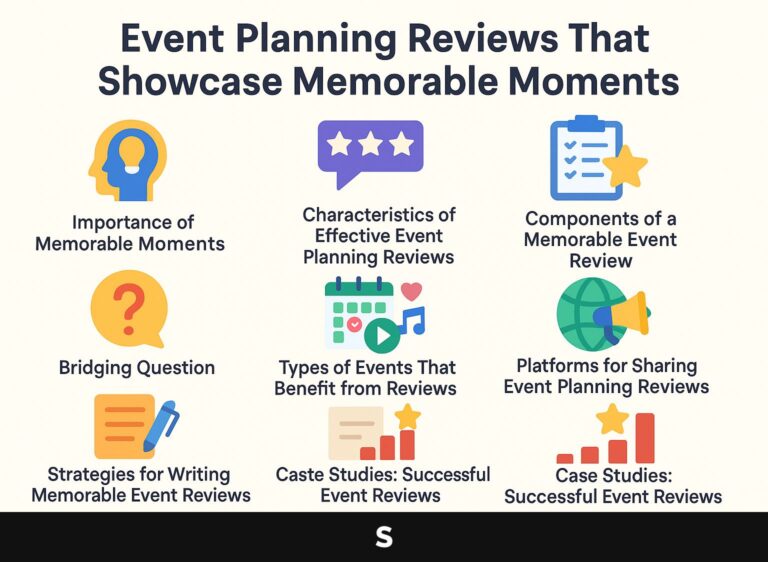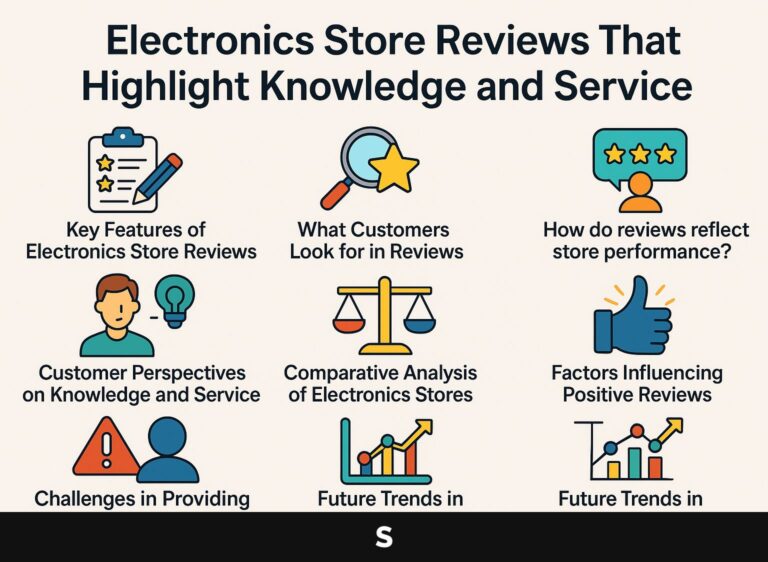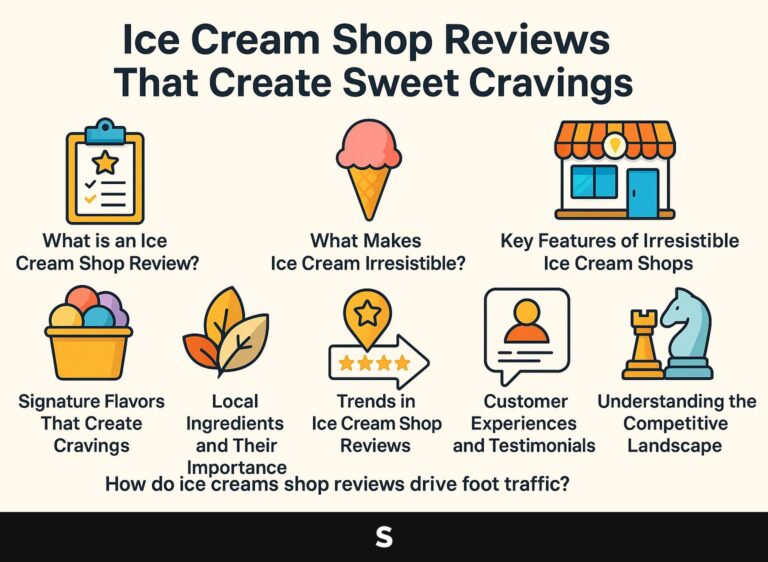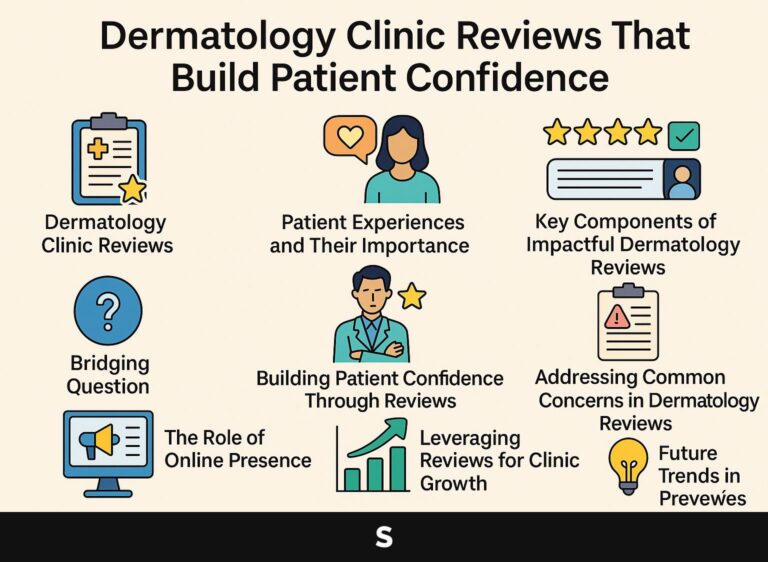Get Reviews Mentioning Specific Employees for Performance Tracking
![]()
Getting customer feedback that mentions individual staff members can change how businesses assess their effectiveness in a busy service setting. With Spokk.io’s staff selection feature, reviews can credit outstanding service to specific technicians, allowing immediate feedback on employee performance. By using this data, companies can improve recognition programs and find training needs based on real service interactions. This article discusses how giving specific feedback can increase your team’s performance and make customers happier.
Key Takeaways:
- Get Reviews Mentioning Specific Employees for Performance Tracking
- Importance of Employee-Specific Reviews
- Spokk.io’s Staff Selection Feature
- Enhancing Customer Experience through Feedback
- Performance Tracking with Employee Mentions
- Recognition Programs Based on Feedback
- Identifying Training Needs through Reviews
- Challenges in Collecting Employee-Specific Reviews
- Best Practices for Encouraging Specific Feedback
- Integration of Feedback into Business Strategy
- Upcoming Changes in Employee Feedback
- Frequently Asked Questions
- How can I track the performance of specific employees using reviews?
- What are the benefits of using reviews to track employee performance?
- Can I select which employees I want reviews to mention?
- How does Spokk.io’s staff selection feature work?
- Is it possible to use reviews for employee recognition programs?
- How do reviews help identify training needs for employees?
Get Reviews Mentioning Specific Employees for Performance Tracking
Feedback about individual employees in reviews lets customers link their experiences to specific team members’ work, which improves responsibility and acknowledgment.
![]()
What is employee-specific feedback in reviews?
Feedback about specific employees includes customer reviews that mention the staff members who provided service, giving a better view of their performance.
This feedback mechanism enables businesses to dissect performance metrics for specific staff members, leading to targeted improvement strategies.
For example, if a review mentions an employee’s great friendliness but points out slow service, management can provide specific training.
Tools like Qualtrics or SurveyMonkey can collect feedback, allowing businesses to notice trends over time.
This personalized approach promotes accountability, urging employees to enhance their abilities and deliver excellent service.
How does it differ from general reviews?
Unlike general reviews that look at the service overall, employee-specific reviews focus on individual contributions, offering useful feedback on performance.
This focus allows managers to identify specific strengths and weaknesses of team members. For example, if an employee regularly hears positive comments about their strong communication skills, this can be used to help them move into leadership roles.
Tools like 15Five and Lattice can help track these specific performance metrics over time, facilitating targeted coaching sessions. Comments from team members about certain projects can serve as evidence during official evaluations, improving the clarity and usefulness of feedback.
This specific method improves employee growth and morale.
Importance of Employee-Specific Reviews
Reviews focused on individual employees are important because they acknowledge great service and help manage performance to improve team morale.
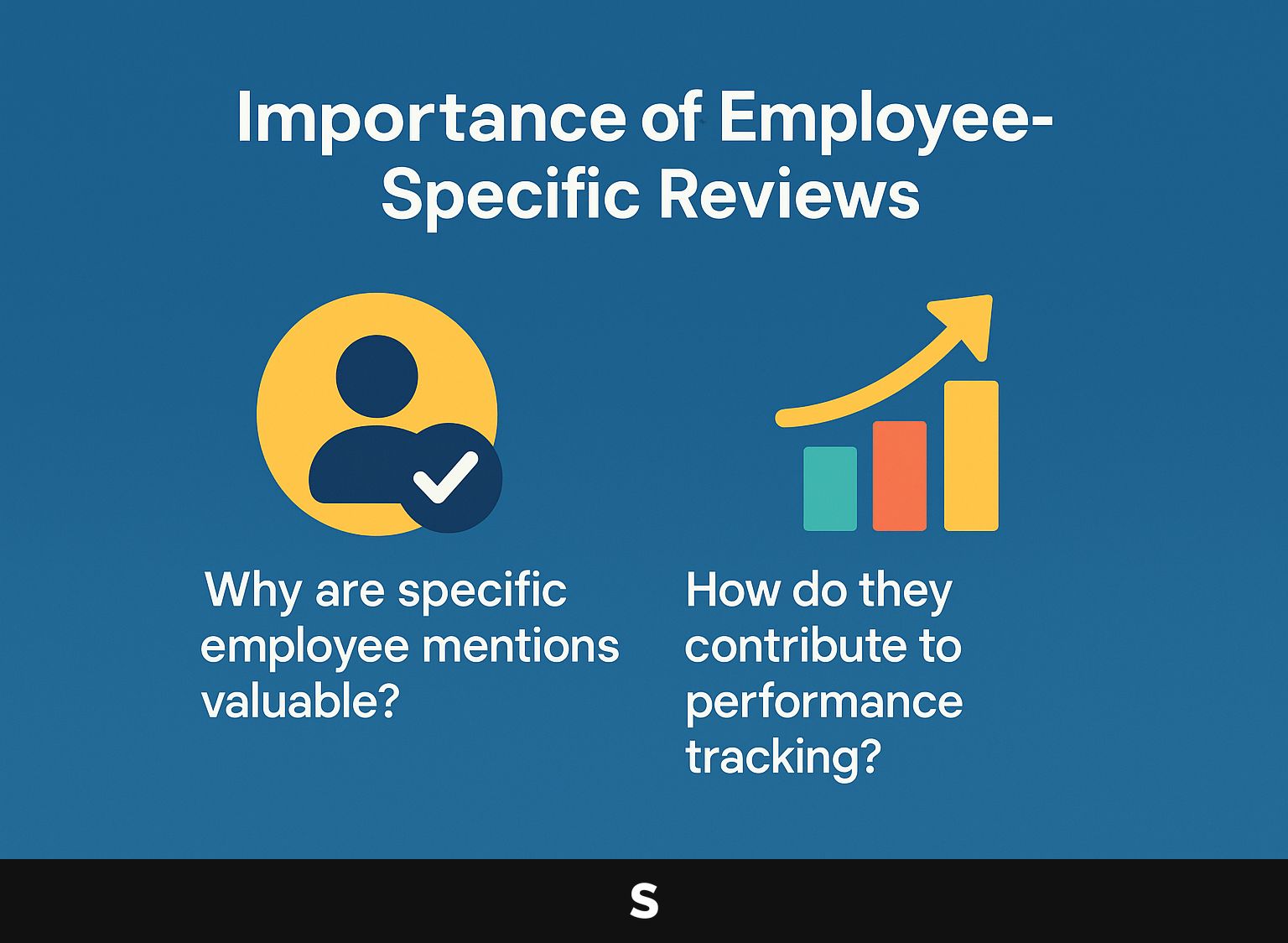
Why are individual employee mentions important?
Mentioning employees by name in reviews is important because it gives them direct recognition, which can improve their morale and help keep them with the company.
Studies show that employees who feel recognized are 60% more likely to report high job satisfaction.
To implement this, create a structured recognition program where managers regularly highlight individual contributions during team meetings or in company newsletters.
Use feedback tools like 15Five or Officevibe to monitor employee engagement and collect feedback.
Using peer-to-peer recognition tools like Bonusly can build a workplace where people feel valued, which improves employee commitment and customer satisfaction.
How do they contribute to performance tracking?
Employee reviews are used to monitor how employees are doing by gathering clear information about what each person has done well and what they need to work on.
To analyze this feedback effectively, businesses should implement tools like SurveyMonkey for customer satisfaction surveys or Zendesk for tracking service quality metrics.
Establish bi-monthly review meetings to discuss findings and monitor key performance indicators (KPIs) such as Net Promoter Score (NPS) or customer retention rates.
Using software like Trello can help manage action items arising from reviews, ensuring accountability and improvement.
By carefully checking individual feedback and related measurements, companies can create focused plans to improve overall performance.
Spokk.io’s Staff Selection Feature
Spokk.io’s staff selection feature allows customers to pick the employee who helped them, simplifying the process for giving detailed feedback and carrying out performance evaluations.
How does the feature work for customers?
Spokk.io allows customers to pick which team member they want to review, simplifying the feedback process.
This targeted interaction allows feedback to be directly associated with individual staff performance, enhancing accountability.
Once a team member is selected, customers fill out an easy survey where they rate their experience and write comments. A user might comment on how professional the assistant is and describe their problems with the service.
This process makes reviews better and helps management find strengths and areas that need training, supporting ongoing development.
What are the benefits for businesses using Spokk.io?
Businesses using Spokk.io get useful feedback that helps improve employee performance and customer satisfaction.
The platform offers important advantages, such as better performance tracking, enabling managers to watch employee progress as it happens.
It recognizes top performers, fostering a culture of appreciation and support among team members.
Spokk.io offers personalized training by using feedback data, ensuring that the learning programs target specific skill gaps.
For example, if feedback highlights a lack of customer service skills in a department, targeted training can be implemented to address this issue directly.
This method improves both employee growth and company results.
Enhancing Customer Experience through Feedback
Feedback gathered from employee reviews helps improve the customer experience by allowing for specific service improvements. If you’re interested in exploring strategies on how to effectively utilize feedback for such enhancements, you might find our Ultimate Guide To Customer Feedback Strategy For Business insightful.
![]()
How does giving individual feedback make service better?
Personal feedback connects customer experiences with how employees perform, resulting in specific improvements in service quality.
For example, a restaurant chain might implement a feedback system where diners can rate their service experience through a mobile app. Analyzing this data reveals patterns, such as servers consistently receiving low scores during busy hours.
In response, management may decide to adjust scheduling, ensuring more staff are available during peak times. Training programs can be customized to address particular weaknesses mentioned in feedback. This proactive approach improves service quality and increases customer loyalty by showing that their feedback is listened to and used.
What role does customer satisfaction play in reviews?
Customer satisfaction significantly influences reviews, as satisfied customers are more likely to leave positive feedback reflecting the quality of service received.
To improve customer satisfaction, businesses should use a service model focused on the customer. Start by actively soliciting feedback through surveys or follow-up calls.
For instance, tools like SurveyMonkey or Google Forms can facilitate quick and effective feedback collection.
Training staff on empathetic communication techniques can create more positive interactions. Implementing a system to analyze customer complaints and compliments helps identify areas needing improvement, ensuring consistent service quality.
When businesses focus on customer experience, they make people happier and are more likely to get good reviews.
Performance Tracking with Employee Mentions
Monitoring how often employees are mentioned in reviews helps companies collect information that can lead to planned improvements and responsibility.
![]()
What metrics can be derived from specific mentions?
Specific mentions in customer reviews can reveal metrics such as individual employee satisfaction, service quality ratings, and overall team performance.
For instance, the Net Promoter Score (NPS) can be derived from comments about employee interactions, measuring customer loyalty based on their willingness to recommend the company.
Similarly, Customer Satisfaction Score (CSAT) directly reflects client happiness after specific experiences, often documented in reviews. Monitoring these metrics helps businesses find unnoticed issues, improve employee training, and increase service quality.
Regularly reviewing trends will help you keep high standards and encourage ongoing development within your team.
How can businesses use this data for performance improvement?
Companies can use data from employee mentions to find patterns, acknowledge top workers, and identify areas that need improvement.
To make good use of feedback data, begin by using a feedback management tool such as Qualtrics or SurveyMonkey. Gather information from employee reviews and team discussions to find shared patterns.
- Next, analyze the data to highlight training needs-perhaps using tools like Google Data Studio for visual representation.
- After finding the skill gaps, create training programs focused on those specific skills.
Regularly review your strategies and gather more feedback to keep improving and adjusting to new challenges.
Recognition Programs Based on Feedback
Creating recognition programs based on customer feedback can greatly improve employee morale and retention, as it shows appreciation for their service efforts.
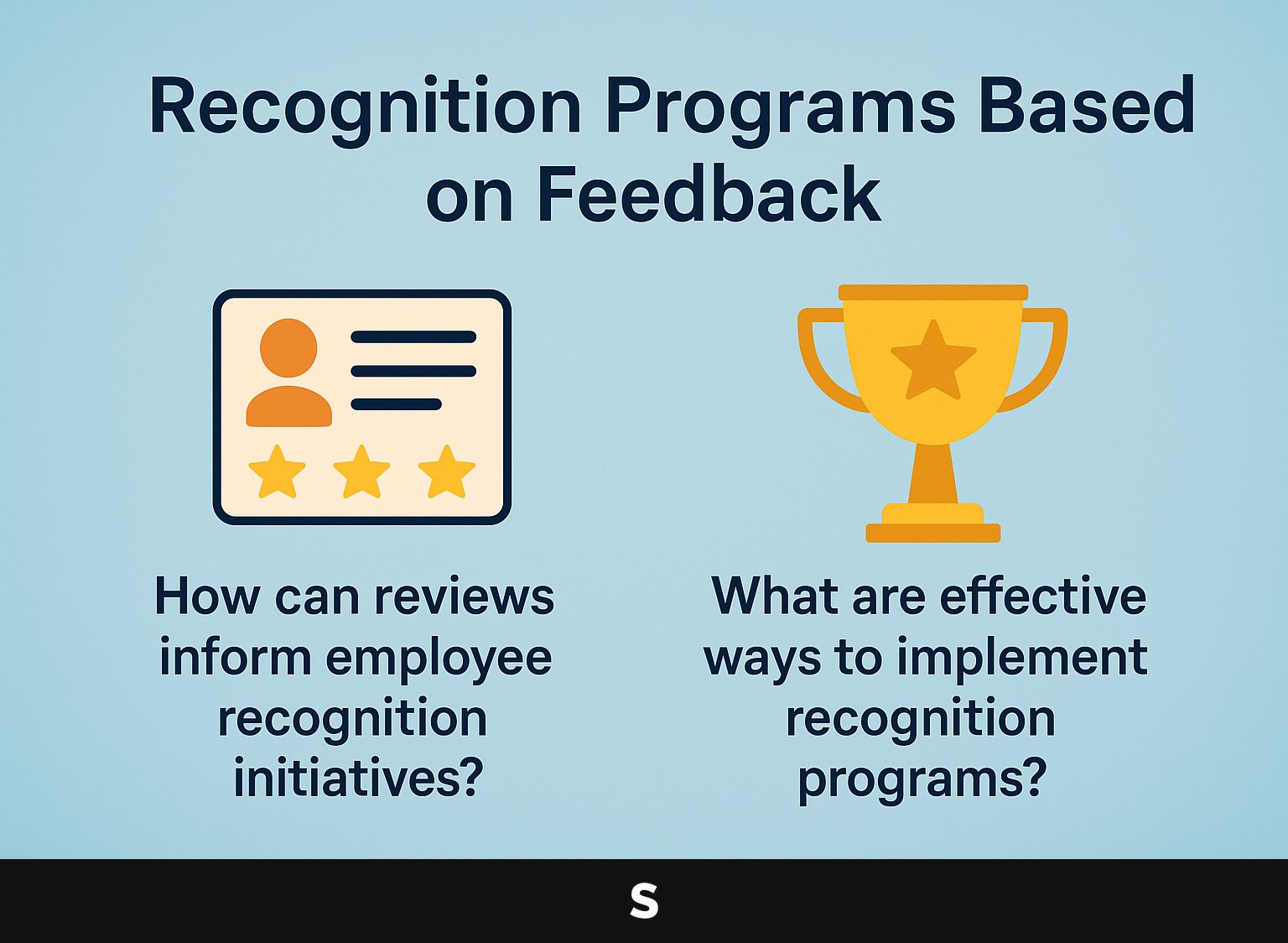
How can reviews inform employee recognition initiatives?
Customer reviews provide important information that can guide recognition programs for employees, highlighting those who perform exceptionally in service.
To use this feedback well, businesses should set up a process to review and examine feedback each month.
Start by using tools like Google Forms to gather customer feedback and sentiment analysis software like MonkeyLearn to quantify positive attributes related to employees. Identify standout employees based on specific metrics, such as those who receive recurring praise for their responsiveness or exceptional service.
Create a recognition program, such as `Employee of the Month,’ offering rewards like gift cards or public acknowledgment during team meetings. This promotes motivation and a supportive work culture.
What are effective ways to implement recognition programs?
Effective recognition programs can be implemented through a variety of methods, including peer shout-outs, award systems, and performance-based incentives.
To establish a successful recognition program, start by designing a peer shout-out platform. Tools like Bonusly allow employees to give each other points for commendable work, which can then be redeemed for rewards.
Next, create an award system, such as a ‘Employee of the Month’ program, using criteria that reflect company values. Implementing monthly reviews can help measure the impact of these programs on morale.
Regularly ask employees how involved they feel and change the program based on their feedback to keep it meeting their needs.
Identifying Training Needs through Reviews
Customer feedback can show where employees need improvement, giving a clear plan for focused training. For instance, our article on 12 powerful examples of constructive feedback within a team provides actionable insights that can be directly applied to enhance team performance.
![]()
How can feedback highlight skill gaps among employees?
Feedback that mentions specific employee challenges can reveal skill gaps, allowing managers to tailor training efforts effectively.
To analyze customer feedback effectively, start by collecting data through surveys or performance reviews. Tools like SurveyMonkey or Google Forms can help you design targeted questionnaires.
Next, categorize the feedback by identifying common themes, such as time management or communication skills. Use qualitative analysis software like NVivo to dig deeper into these themes and quantify gaps.
Prioritize the skill gaps based on frequency and impact, enabling you to tailor training sessions that address the most pressing needs. This process uses a careful plan for developing employees.
What training methods can be developed from customer feedback?
Customer feedback can result in different training methods, like workshops, online courses, or one-on-one coaching sessions focused on specific improvement areas.
For example, a company might implement a workshop focused on team collaboration, using feedback that cited communication issues. This could include role-playing activities to improve communication skills.
Online courses covering time management techniques can cater to remote workers’ needs, with platforms like LinkedIn Learning proving effective for ongoing development.
You can measure effectiveness by using surveys before and after training. These surveys can show a productivity increase of at least 30%, highlighting the value of methods designed based on customer feedback.
Challenges in Collecting Employee-Specific Reviews
Gathering reviews focused on individual employees has difficulties, like possible bias in the feedback and low response rates from customers.
What are common obstacles businesses face?
Common challenges include customers being biased towards sharing only negative experiences or not being interested in giving feedback.
These challenges can greatly affect the quality of the feedback gathered. For example, if unhappy customers are the only ones writing reviews, the feedback will probably be mostly negative.
To mitigate this, consider implementing follow-up surveys after positive experiences, encouraging a broader range of responses. Tools like SurveyMonkey and Google Forms can facilitate this process.
Encouraging a habit of sharing feedback in your team can inspire employees to join in review processes, which helps in getting a fair view of performance.
How can these challenges be mitigated?
Mitigating challenges involves implementing strategies to encourage balanced feedback and increase customer participation rates.
One effective approach is to incentivize feedback by offering discounts, freebies, or entry into a prize draw.
Tools like SurveyMonkey can help you create engaging surveys, while platforms like Typeform provide visually appealing forms that encourage completion. Sending follow-up messages like thank-you emails or notifications can greatly increase how often people respond.
For instance, after a purchase, send a feedback request within a week to keep the experience fresh in the customer’s mind. Use these methods together to build a complete feedback plan that gives useful information.
Best Practices for Encouraging Specific Feedback
To get specific feedback, use thoughtful methods that improve communication with customers and encourage clear answers.
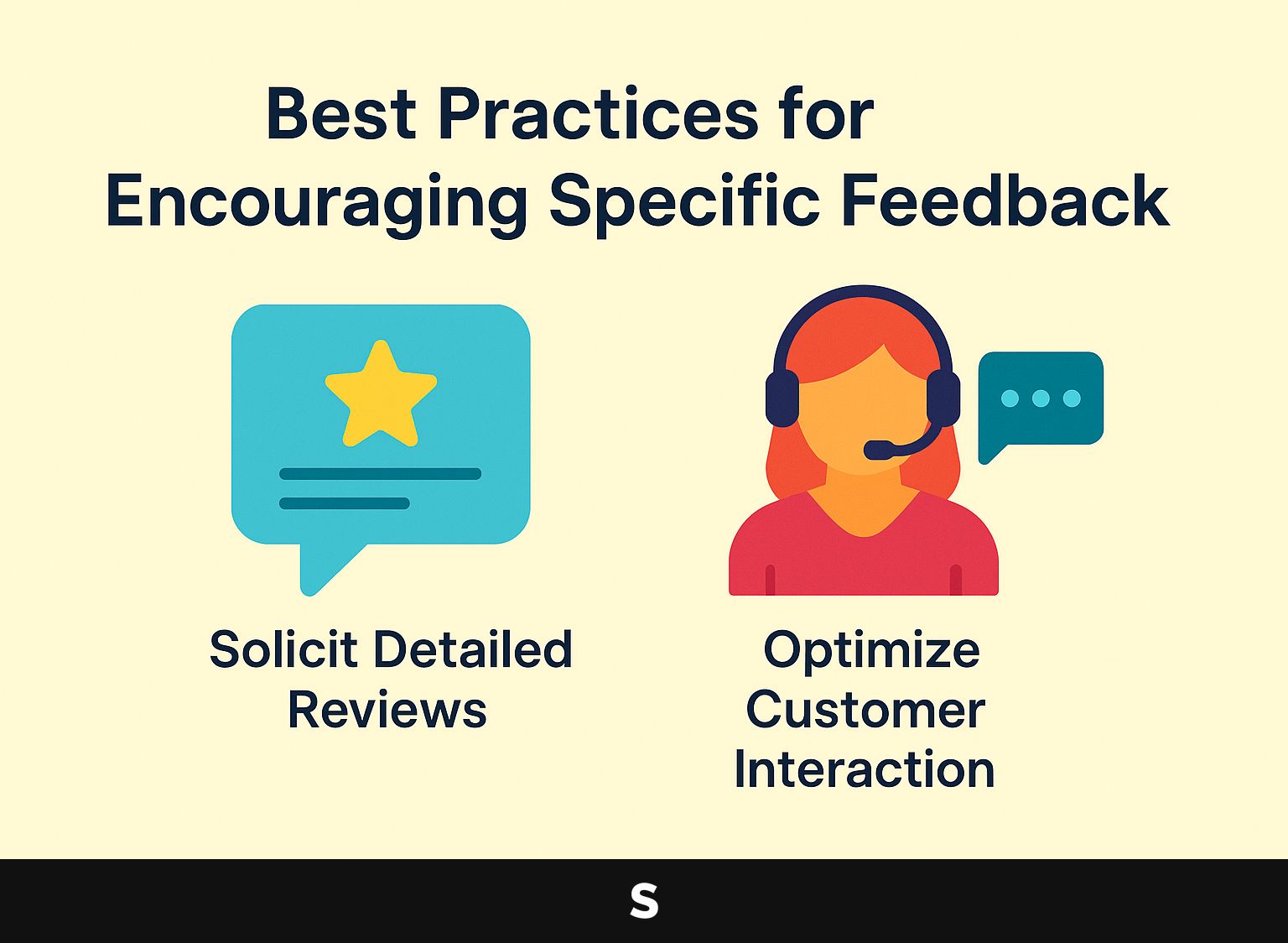
What strategies can businesses use to solicit detailed reviews?
Businesses can use strategies like individualized follow-ups and specific surveys to gather more detailed customer reviews.
One effective method is to send a customized email after a purchase, thanking customers and inviting them to share their thoughts.
Think about using post-service surveys with open-ended questions to gather more detailed feedback. For example, a restaurant might ask, “What was your favorite dish, and why?” This encourages customers to elaborate.
A different method is giving discounts on upcoming orders in return for thorough reviews. Sharing customer reviews on social media can encourage others to give detailed feedback, improving your brand story.
How can we improve customer interaction to gather feedback more effectively?
Better ways to collect feedback from customers involve simplifying the process for them to express their thoughts.
- Start by asking for feedback at key moments, such as after a purchase or customer support interaction. Use clear, concise questions that focus on specific experiences.
- For example, instead of asking a broad question like `How was your service?’, try asking `How would you rate the speed of our response?’ Use simple tools like SurveyMonkey for quick surveys or Typeform for creating feedback forms that hold people’s attention.
- Respond quickly to feedback to show customers their opinions are valued, building a more engaging and trustworthy connection.
Integration of Feedback into Business Strategy
Using employee-specific reviews in business strategy helps make better decisions and improves performance management systems. For a comprehensive approach, integrating customer feedback can further enhance this strategy. Worth exploring: our ultimate guide to customer feedback strategy.
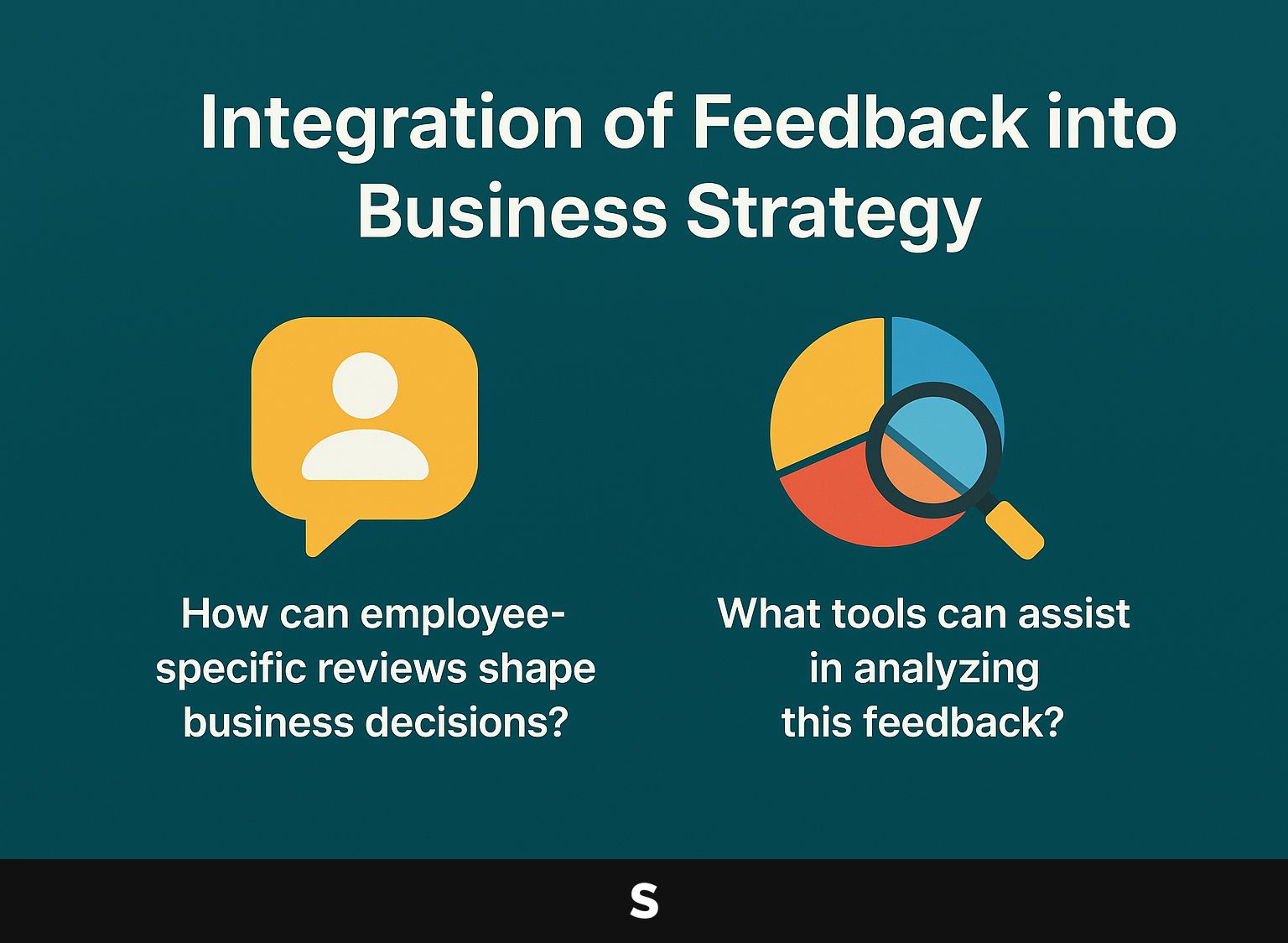
How can employee-specific reviews shape business decisions?
Reviews focused on individual employees can influence business choices by giving clear feedback on how customers view each staff member.
Businesses can make good use of employee feedback by often looking at performance surveys and customer reviews.
For instance, if multiple patrons highlight that a specific employee excels in service but lacks product knowledge, this informs training opportunities.
Tools like SurveyMonkey or Google Forms can make it easier to gather feedback.
Checking this feedback every three months helps management spot patterns, like the need for better training in customer service skills or knowledge about the product.
This organized method helps employees develop and makes customers happier, encouraging a company culture that responds quickly to needs.
What tools can help analyze this feedback?
Using feedback analysis tools can greatly improve how businesses understand customer feedback and find useful measurements.
There are several useful tools for analyzing employee feedback. For instance, SurveyMonkey offers customizable surveys that can gauge employee satisfaction, with real-time analytics to track trends.
Likewise, Qualtrics offers detailed analysis to find more information from feedback, helping companies make changes fast.
Another excellent option is Culture Amp, which specializes in employee engagement and offers benchmarks against industry standards. Officevibe focuses on continuous feedback through pulse surveys, helping teams stay agile.
By selecting the right tools, organizations can effectively translate feedback into meaningful improvements.
Upcoming Changes in Employee Feedback
New technologies will alter how companies manage employee feedback, making it quicker and giving more helpful information.
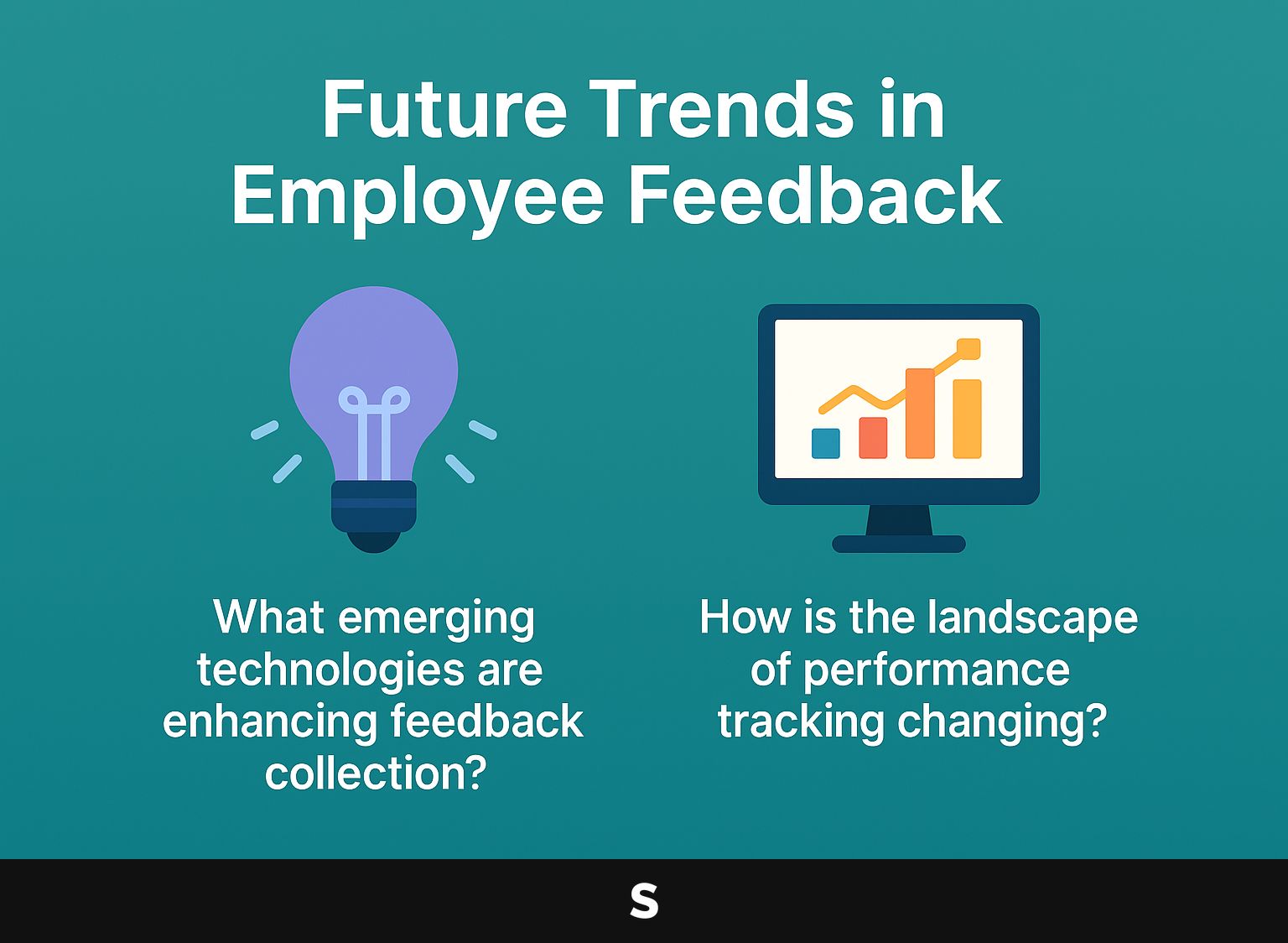
What emerging technologies are enhancing feedback collection?
Emerging technologies such as AI-driven feedback tools and real-time analytics platforms are enhancing the methods for collecting customer feedback.
For example, platforms like Qualtrics and Medallia use AI to quickly examine a lot of feedback, helping businesses understand what customers think.
These tools help businesses sort responses, identify patterns, and even forecast upcoming actions.
Using tools like Google Analytics alongside these can improve engagement by tracking how users react to feedback requests.
Using these technologies makes it easier to handle feedback and improves customer experiences, which increases loyalty and satisfaction.
How is performance tracking changing?
Performance tracking is changing to focus more on using data and learning from it, with an emphasis on keeping employees engaged.
Organizations are using real-time data analysis to understand how employees are performing. For example, tools like Tableau and Power BI can show performance metrics, helping managers spot trends and areas that need improvement.
Using feedback tools like 360-degree reviews or quick surveys helps create a complete evaluation system. Companies can also adopt Continuous Performance Management (CPM) systems that allow for ongoing feedback, aligning employee goals with organizational objectives.
This repeated process encourages a culture of growth and flexibility.
Frequently Asked Questions
How can I track the performance of specific employees using reviews?
With Spokk.io’s staff selection feature, customers are able to choose which employee served them before leaving feedback. This lets reviews be assigned to individual team members, making it simple to monitor their performance.
What are the benefits of using reviews to track employee performance?
Reviews provide real customer feedback which can be used to create recognition programs, identify training needs, and track the performance of specific employees. This leads to improved employee development and overall customer satisfaction.
Can I select which employees I want reviews to mention?
Yes, with Spokk.io’s staff selection feature, you can choose which employees you want customers to mention in their reviews. This allows for targeted performance tracking and analysis for specific team members.
How does Spokk.io’s staff selection feature work?
The staff selection feature asks customers to pick the employee who helped them before they leave feedback. This information links the review to the particular team member, providing useful data for tracking performance and making improvements.
Is it possible to use reviews for employee recognition programs?
Absolutely. The reviews mentioning specific employees can be used to create recognition programs for outstanding performance. This improves employee morale and encourages them to continue providing excellent service to customers.
How do reviews help identify training needs for employees?
By tracking reviews mentioning specific employees, patterns and areas for improvement can be identified. This information can then be used to develop targeted training programs for employees, leading to improved performance and customer satisfaction.
